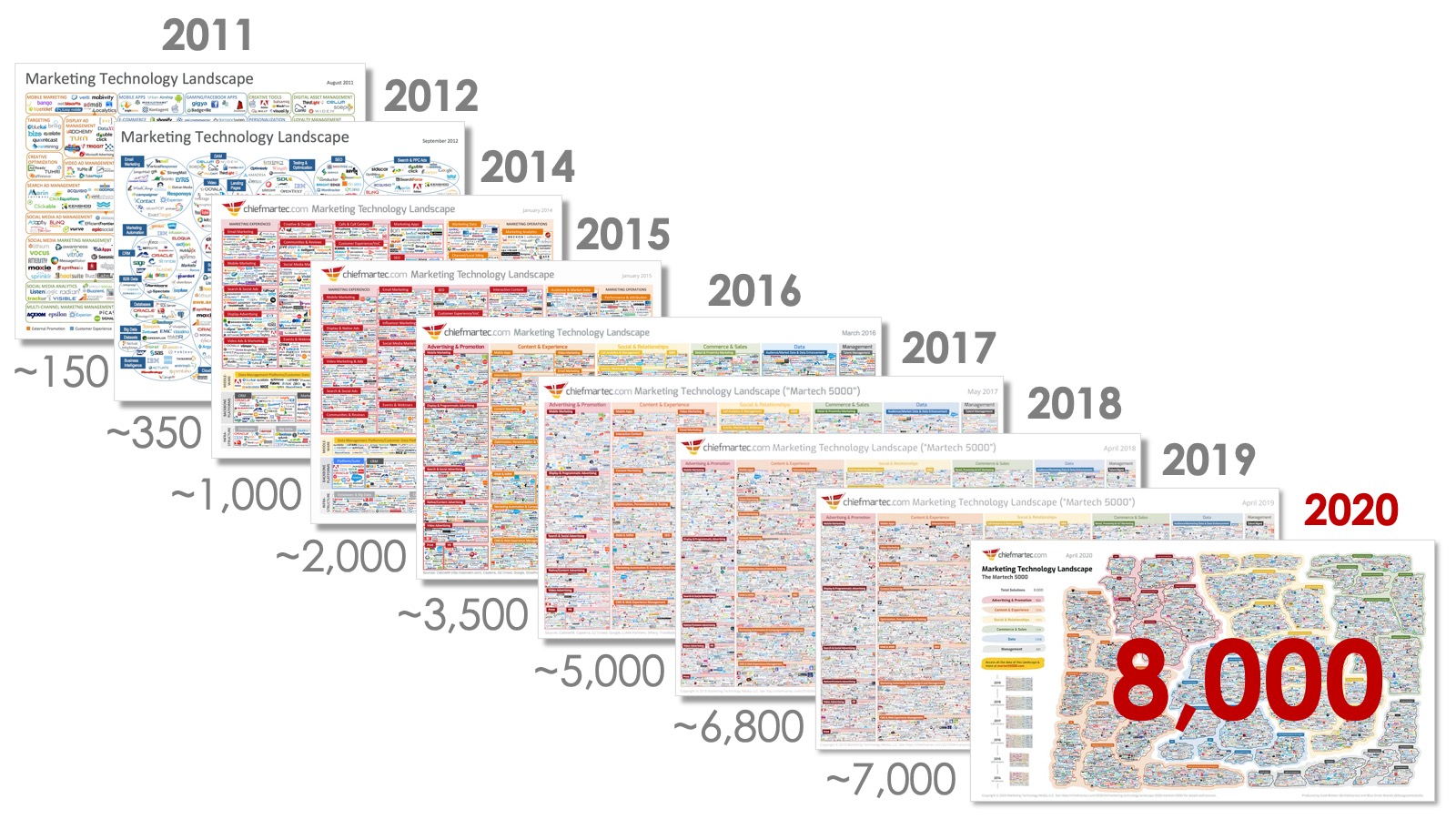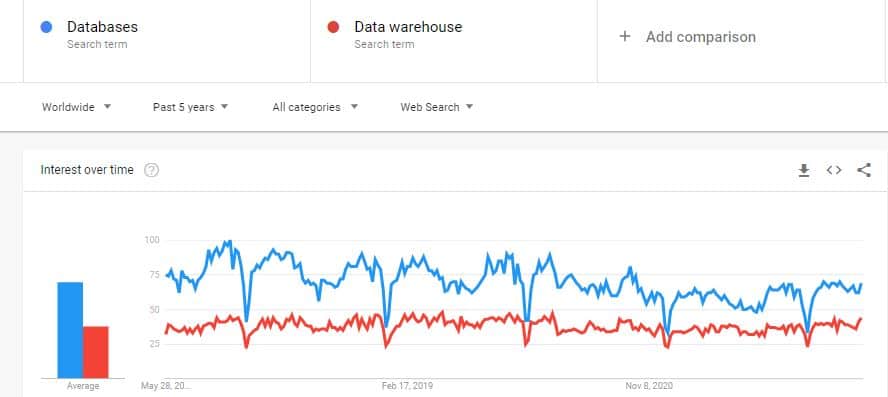An Introduction to Snowflake, the Marketing Data Warehouse for Marketers and Analysts
- Datameer, Inc.
- May 25, 2022

This article will introduce the concept of cloud data warehousing, its benefits, and a personal recommendation for our go-to data warehouse, the Snowflake marketing data warehouse. If this interests you, then please stay stick around!
According to the 2020 Martech landscape statistic, the number of marketing tools and technology has gone up by more than 80% since 2019.
See below:

This sounds like great news for marketing professionals, right ?… Yeah probably
However, this quickly turns into a problem as we start to see more marketing silos created due to disparate marketing channels.- hence the need for a data warehouse.
What is a Data Warehouse?

Google trends comparing the search frequency of the terms “data warehouses” and “databases.”
Within the last five years, we see an increase in the search for the term “databases,” but this pales compared to its peer, data warehouses.
We can assume that most people are more conversant with databases than warehouses.
So what’s a data warehouse, and how is it different from databases?
Snowflake marketing data warehouse
According to Wikipedia,
“A Datawarehouse is a central repository of integrated data used for reporting and analysis.”
Databases vs. Data warehousing software
Databases are built to store structured data. Often that “data” is solely transactional data generated within your applications. One drawback with databases is the inability to accommodate large-scale analytics and reporting.
Conversely, data warehousing software is built to house data from a variety of sources along with querying capabilities to support your large-scale analytics and reporting scenarios.
On-Prem Vs. Cloud Data warehouses
Data warehouses can be separated into two main categories;
- Traditional/On-prem Data warehouses: What makes a Data warehouse on-premise is the presence of physical servers, and in-house managed IT infrastructure. Your enterprise manages the maintenance, computing resource management, and storage processes.
Some examples of On-prem DWs are IBM Integrated Analytics System, SAP HANA, and Micro Focus Vertica Enterprise On-Premise.
- Cloud-Based Data warehouses
With Cloud data warehouse solutions, you get an as-is Platform /Software/ Infrastructure as a service. The Service Provider manages processes like maintenance, updating, computing resource management, and storage.
A few examples of these solutions are Snowflake, Google Big Query, and Amazon Redshift.
Tip: Before you decide on which DW solution to settle for (Cloud or On-prem), make sure to get a professional data architect to assess your organization’s marketing channels, ETL possibilities, budget, and use cases. This will enable you to pick a befitting solution for your organization.
What makes a Good Marketing Cloud DW Solution?
Selecting a marketing-focused data warehouse solution can be daunting due to the super technical (although necessary) jargon associated with data warehousing architectures.
This section will share some key questions you should be asking your IT team during the business requirements gathering phase of any marketing DW deployment project.
Does it enable us to have a 360 view of our Customers? – A good marketing warehouse should be able to serve as a centralized , single source of truth for all your marketing data. It should be before converging data from all your customer touchpoints in one place.
Can It handle multiple workloads? One key characteristic of an excellent data warehouse is accomplishing analytics and accommodating other workloads and capabilities like Machine Learning, Data Governance, and Business Intelligence.
Is it Scalable?– Cloud technology boasts scalability and extensive storage capability. It’s a no-brainer that a good data warehouse should be able to handle all sorts of data, whether large, historical, streaming or extensive marketing data.
The Snowflake Cloud Data Platform – Our recommended DW for Marketing teams
What is Snowflake?
Snowflake is a data warehouse deployed on top of the Amazon, Microsoft, or Google Cloud infrastructure and allows storage and computing to scale independently.
If you’re searching for a cost-effective, scalable, and marketing-focused warehouse, this might be the right fit for you.
According to Snowflake, “Snowflake is a true data platform-as-a-service that handles infrastructure, optimization, infrastructure, data protection, and availability automatically, so businesses can focus on using data and not managing it.”
Here’s are some benefits you stand to gain with a Snowflake marketing data warehouse:
- One Platform for all your Customer data: With Snowflake, all data generated within your various marketing channels can be easily ingested into a Snowflake. Irrespective of how your marketing channels parse data, whether quick streams of data from your website or structured data from your CRM, Snowflake can handle all of it!
Snowflake also partners with various data technology providers to assist you with the ingestion process and other ETL processes.
- Effective Workload Management:
Snowflake can support multiple workloads on a single copy of data. There is no need to move data around to different environments with Snowflake.
With Snowflake, all your Ad-hoc, BI, Compliance, or even data science workloads can occur in isolation without interference or a trade-off for speed.
- Supporting Scale And Performance: Imagine having hundreds of analytic users logging in on a Monday morning to query your Warehouse, sounds like a heavy workload, yeah?… Definitely!
Snowflake leverages features like multi-clustering and on-demand Warehouse Up-Scaling to handle these situations.
Possible Drawbacks of data warehousing for marketing teams
Although warehousing is excellent for marketing teams and organizations, deploying one is easier said than done. Experts who have deployed data warehouses have found some of these challenges they encounter when deploying a warehouse:
- Heterogeneous Data: As data is pulled from disparate marketing channels, formats, structures, and types may be different.
Heterogenous Connections: If we recall the Martech statistic in our introduction, we see multiple technologies frequently emerging in marketing.
It’s important to note that every platform has different APIs and application layers.
Without proper data engineering, you can run into connectivity issues when deploying your Warehouse.
Tip: To achieve that ideal Customer 360, your organization has to invest in building or buying a data pipeline/ pipeline as a service.
- Marketers Vs. Analysts: Most data warehouses are based on relational database models. This means that one would require technical knowledge of SQL to query or model data in the DW.
This is no issue for the analytics team, but for the non savvy marketing team who have to rely on IT for all their reporting requirements
Datameer: Bridging the Marketers Vs. Analysts Divide
In the previous section, we discussed the divide that tends to exist between the core marketers and the analysts in the context of data warehousing.
Experts agree that a good data strategy involves making your data accessible; at a ratio of 80% self-service and 20% Ad-hoc for more technical queries. That means that marketers should be able to get to do most of their basic reporting without reliance on IT.
There are two ways to achieve this; you can invest in upskilling your marketing team with SQL training or leverage collaborative multi-person data transformation tools like Datameer.
With Datameer, you bring together your entire team– data engineers, analytics engineers, analysts, and data scientists – on a single platform to collaboratively transform and model data for faster, error-free projects.
Bridge that gap by integrating Datameer with your Snowflake marketing data warehouse.


